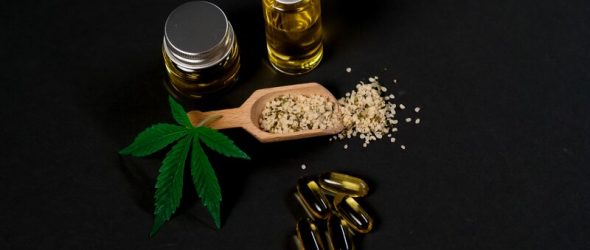If you’re new to CBD or even just curious about it, you’d be forgiven for conflating the terms “hemp” and “CBD”—especially when the product labels you’re googling seem to do just that. Why are some products labeled “hemp” and others labeled “CBD”, and what is the difference?
As it turns out, the word “label” is important here. Your confusing CBD shopping experience has a lot to do with both slowly evolving FDA regulations and a general lack of consumer education in an industry that is growing at breakneck speed. So, how do you tell which is which, and why does it matter?
Difference Between Hemp and CBD
Among the species Cannabis sativa, there are two varieties or cultivars. One of those varieties is typically referred to as cannabis or marijuana, while the other is called hemp. Cannabis contains about 17 percent tetrahydrocannabinol (THC), the psychoactive compound that makes you feel high when you smoke a joint. Hemp is cultivated in such a way that it contains less than 0.3 percent THC, the maximum allowable amount to be sold legally in the United States. So, it’s not psychoactive.
However, the tables turn when considering cannabidiol (CBD), the phytocannabinoid that’s commonly used as a supplement to ease sore muscles, help manage stress, support sleep, and so on. While modern cannabis plants typically average a CBD content of less than 0.15 percent, hemp plants are cultivated to contain about 12 to 18 percent CBD, which can be found in all parts of the plant except the seeds (going deeper down the rabbit hole, this means that products labeled as “hemp seed oil” contain negligibly trace amounts of CBD, which usually makes them much cheaper).
The Labeling Issue
Here’s an interesting exercise: Type “CBD” into Amazon’s search bar. From sleep supplements to joint treatments for dogs, you’ll get many results labeling themselves as “hemp” or “hemp oil,” but you won’t see the term “CBD” on any of these items. Does that mean they’re CBD-free? Not necessarily. Reading the ingredients labels, you can generally figure that out yourself.
Products that contain full-spectrum hemp, hemp oil, hemp extracts, or, of course, cannabidiol, typically contain CBD, while the term “seed” (like “cannabis Sativa seed oil”) indicates hemp seed oil. Manufactured cannabis products feature THC and CBD content labels on the package, per various state regulations where they’re legal.
You’ll also notice the absence of paid advertising for products labeled as “CBD” on Facebook, Instagram, and Google, but can effortlessly find products labeled as hemp oil, hemp extract, or hemp capsules.
Why the apparent shyness when (all things being equal) it’s likely the same product?
Essentially, the U.S. Food and Drug Administration (FDA) is still coping with the “green rush” that ensued after 2018 legalized industrial hemp and is grappling with conflicts related to pharmaceutical use vs recreational use of CBD. To date, the FDA has approved one pharmaceutical-grade CBD product used for epilepsy treatment but has not yet released clear regulations regarding recreational or over-the-counter use.
At the moment, the FDA’s stance on CBD is a work in progress. Straight from the source in a late 2019 consumer update, the organization said, “The FDA recognizes the significant public interest in cannabis and cannabis-derived compounds, particularly CBD” and that it is “evaluating the regulatory frameworks that apply to certain cannabis-derived products.” Simultaneously, the marketing and labeling of CBD brands often err toward carefully worded “hemp” products to avoid enforcement action from the FDA, such as a response to making false health claims. For responsible companies, who are not making false health claims, this is limiting their ability to communicate with their customers.
Unfortunately, for the consumer is the FDA’s stance is creating unnecessary confusion and making it more difficult to learn about and purchase the products you are looking for.
What to Look for
For the time being, whether a product is labeled as “CBD” or “Hemp Extract”, consumers and manufacturers must shoulder a little more responsibility. Industry leaders must work to ensure safe products with clear accurate labeling and essential third-party testing — while consumers need to be aware of some key factors to look for to ensure the CBD products they are consuming are both safe and effective.
Third-party testing is perhaps the most crucial way to achieve this, allowing consumers to identify exactly what they are putting in their bodies and ensure the products they are consuming are safely processed from top to bottom. At a bare minimum, you should be looking for brands that display recent third-party lab results to validate potency and purity. Labels like certified non-GMO, organic, and vegan typically indicate a higher quality product.
Some companies take it even further. FOCL, for instance, undergoes TRU-ID certification, an independent, thirty-party program that uses bleeding-edge DNA testing to measure ingredient integrity in some of our products that include a variety of natural ingredients. Likewise, all of our facilities voluntarily comply with FDA-developed Good Manufacturing Practice, an industry-standard regulatory system.
These aren’t the only testing or regulatory measures out there, but they serve as an example of the types of good-faith safety and quality measures you as a consumer should be on the lookout for to ensure a healthy, effective CBD experience — and practices like these are a big reason why 37 percent of respondents told High-Yield Insights they were more likely or even “excited” to purchase cannabis products from known brands in 2019.
Transparency matters. Before you buy CBD, find out that it’s been tested by an agency outside the seller, know where the hemp comes from, and understand the conditions under which it’s processed. Don’t fear long labels. Seek products that have nothing to hide before you put a capsule into your mouth, a tincture under your tongue, or a relief cream onto your skin. CBD is widely believed to have many benefits, but like anything you put into your body, do your diligence first and get to know who you are ultimately trusting with your health and wellness.


